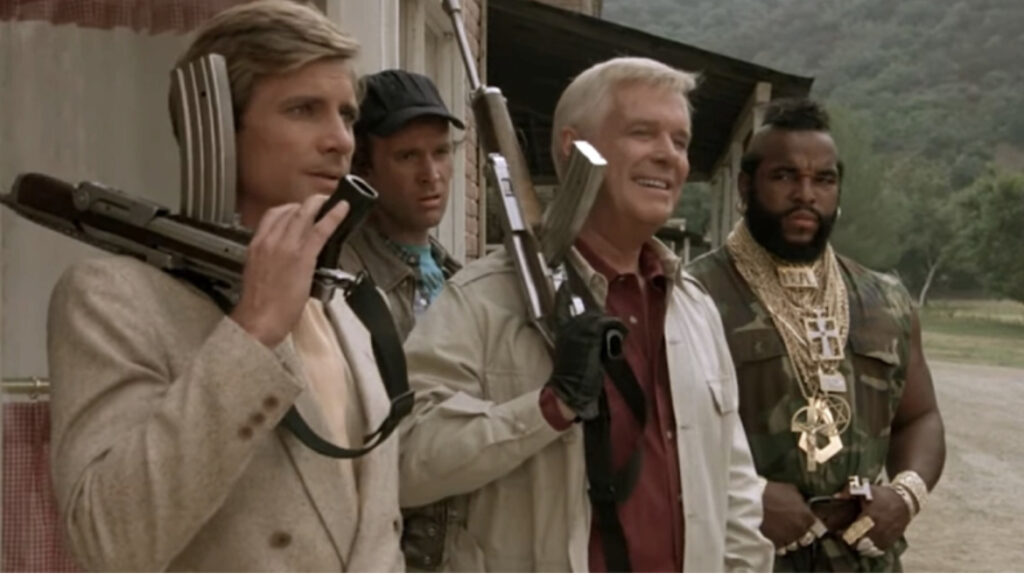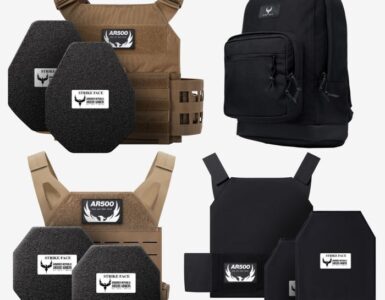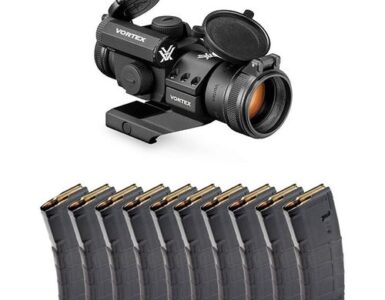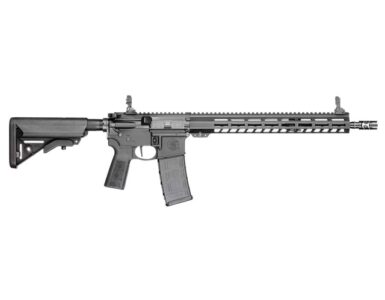
Table of Contents
Section 1: Inspiration from the M14 and Design Origins
The Ruger Mini-14, while distinct in its category, owes much of its design philosophy and mechanical lineage to the M14 rifle. The M14, developed as a successor to the legendary M1 Garand, was a standard-issue rifle in the U.S. military during the 1950s and 1960s. This battle rifle was known for its power, reliability, and the iconic design elements it inherited from the Garand, including the gas-operated action and rotating bolt mechanism.
When William B. Ruger, co-founder of Sturm, Ruger & Co., and his chief engineer, L. James Sullivan, embarked on designing the Mini-14, their goal was to capture the essence of the M14’s reliable functionality in a smaller, more versatile package suitable for civilian use. Ruger, already renowned for his expertise in crafting innovative firearms, sought to create a rifle that was practical for a wide range of users – from ranchers and farmers to law enforcement and sport shooters.
L. James Sullivan, who played a pivotal role in the design of the Mini-14, was a talented firearms designer. Prior to his work with Ruger, Sullivan had contributed to the design of the AR-15 while working at Armalite. His experience with both military and civilian firearm design was instrumental in the development of the Mini-14. The challenge was to adapt the robust and battle-proven features of the M14 into a lighter, more compact rifle that still retained high reliability and versatility.
The influence of the M14 is evident in several aspects of the Mini-14’s design. For instance, the gas-operated action and the rotating bolt are direct adaptations from the M14, offering proven reliability. However, Sullivan and Ruger made significant modifications to reduce the size and weight of the Mini-14, making it more suitable for non-military applications. This included using lighter materials and simplifying the design, while ensuring that the rifle maintained a balance of durability and ease of handling.
In essence, the Ruger Mini-14 emerged as a successful fusion of the rugged, reliable elements of the M14 and innovative adaptations tailored to the needs of civilian users. Its design process is a testament to William B. Ruger and L. James Sullivan’s vision of creating a versatile, dependable, and accessible semi-automatic rifle, inspired by one of the most iconic military firearms of the 20th century.
The Ruger Mini-14, a lightweight semi-automatic rifle, has an interesting history and design lineage that traces back to the iconic M14 rifle used by the U.S. military.
Certainly! Here’s an expanded version of Section 2, focusing on the Development and Introduction of the Ruger Mini-14:
Section 2: Development and Introduction of the Ruger Mini-14
The development journey of the Ruger Mini-14 began in the late 1960s, driven by the vision of William B. Ruger and his team to create a practical and versatile semi-automatic rifle. The goal was to harness the reliability and proven design features of military rifles like the M14, but in a form factor that was suitable for civilian use, including law enforcement, ranching, hunting, and recreational shooting.
William B. Ruger, already well-known for his innovation in firearm design and manufacturing, was keenly aware of the market demand for a rugged, yet compact and lightweight rifle. He saw potential in adapting the design principles of the M14 to create a firearm that was easier to handle and more versatile for non-military users. The Mini-14 was to be a rifle that combined the best elements of military-grade weapons with the needs of everyday users.
During its development, the focus was on ensuring that the Mini-14 was not only reliable but also simple to manufacture and maintain. Ruger and his team worked meticulously on the design, paying special attention to the rifle’s mechanism and usability. They opted for a traditional wood stock in its initial models, which appealed to users familiar with classic rifle designs. The gas-operated action with a rotating bolt, directly inspired by the M14, was re-engineered to fit the smaller, more lightweight frame of the Mini-14.
The Mini-14 was officially introduced to the public in 1973. Upon its release, it quickly gained popularity due to its straightforward design, ease of use, and reliability. The rifle was chambered for the .223 Remington cartridge, making it compatible with a widely available and popular round. This choice of caliber also made it appealing to a wide range of users, from those interested in small-game hunting to property owners and law enforcement agencies looking for a dependable utility rifle.
In its early years, the Mini-14 received positive reviews for its performance, particularly its accuracy and reliability. It was praised for being a well-balanced firearm, suitable for both rapid firing and more precise shooting. The Mini-14’s resemblance to military-style rifles, combined with its civilian-friendly applications, helped it carve out a unique niche in the firearms market.
The introduction of the Ruger Mini-14 was a significant event in the firearms industry. It demonstrated that the principles of military firearm design could be successfully adapted to meet the needs of civilian users. The Mini-14’s development and introduction set the stage for its enduring popularity and paved the way for future innovations and variants from Ruger.
Section 3: Design and Features of the Ruger Mini-14
The Ruger Mini-14 is a testament to thoughtful design and practical features, tailored to meet the needs of a diverse user base. Its design is a blend of classic styling and modern engineering, making it both visually appealing and functionally versatile.
Classic Aesthetics with Modern Functionality:
The Mini-14 sports a classic rifle appearance, often featuring a traditional wooden stock that appeals to users with a preference for timeless firearm designs. This aesthetic choice connects the Mini-14 to its historical predecessors while maintaining a distinct identity. In some models, synthetic stocks are used, offering increased durability and weather resistance, catering to users who might use the rifle in more rugged conditions.
Barrel and Action:
The rifle typically features an 18.5-inch barrel, providing a good balance between accuracy and maneuverability. The barrel is cold hammer-forged, a process known for producing durable and precise barrels. The action of the Mini-14, inspired by the M14, is a gas-operated system with a rotating bolt. This mechanism is a key factor in the rifle’s reliable performance, even in adverse conditions or with heavy use.
Caliber and Magazine:
Initially designed for the .223 Remington cartridge, the Mini-14 is compatible with a widely used round, offering versatility in various shooting disciplines, from hunting to target practice. The rifle generally comes with a standard 5-round magazine, with higher capacity magazines available. This flexibility in magazine size allows users to customize the rifle based on their specific needs or local regulations.
Sights and Accuracy:
Out of the box, the Mini-14 is equipped with iron sights, typically including a blade front sight and an adjustable rear sight. These sights are sufficient for typical shooting scenarios. Many models also offer integrated scope mounts, allowing users to attach various optics for enhanced accuracy at longer ranges.
Handling and Ergonomics:
The Mini-14 is designed for ease of handling. It is well-balanced and relatively lightweight, making it comfortable to carry and shoot, even for extended periods. The ergonomics of the rifle are designed to cater to a wide range of shooters, with easy-to-reach controls and a smooth operating action.
Versatility and Adaptability:
One of the standout features of the Mini-14 is its adaptability. It can serve various roles, from a ranch rifle to a home defense firearm, or a recreational shooting tool. Its straightforward design makes it easy to use and maintain, appealing to both experienced shooters and those new to firearms.
Section 4: Variants and Evolution of the Ruger Mini-14
Since its introduction in 1973, the Ruger Mini-14 has undergone numerous refinements and adaptations, resulting in a variety of models and variants that cater to different user needs and preferences.
Mini-14 Ranch Rifle: One of the most notable variants is the Mini-14 Ranch Rifle. Introduced in the 1980s, this version of the Mini-14 features integral scope mounts on the receiver, making it easier for users to add optics. The Ranch Rifle also introduced a new sight system and came equipped with side ejection to clear the mounted scope. This model became immensely popular among ranchers, hunters, and shooters who required a reliable, versatile rifle with the option for enhanced accuracy through scopes.
Mini-30 and Caliber Variations: The Mini-30, a significant variant introduced in 1987, expanded the Mini-14 platform to include the 7.62×39mm caliber. This move broadened the appeal of the Mini series to those who preferred the ballistics and availability of the 7.62×39mm round, commonly used in the AK-47 and SKS rifles. The Mini-30 shares many features with the original Mini-14 but is tailored for the different caliber.
Target and Tactical Models: Ruger also released target and tactical models of the Mini-14. The Target model features a heavier barrel and a harmonic dampener for increased accuracy, appealing to precision shooters and varmint hunters. The Tactical models, meanwhile, come with shorter barrels, flash suppressors, and Picatinny rails for mounting a variety of tactical accessories. These models cater to users looking for a more compact, adaptable firearm for home defense or law enforcement applications.
Material and Design Updates: Over the years, the Mini-14 has seen updates in materials and design to improve performance and durability. Synthetic stocks, stainless steel options, and improved heat dissipation mechanisms are some of the enhancements that have been introduced. These updates have helped keep the Mini-14 relevant and competitive in the evolving firearms market.
Special Editions and Customizations: Ruger has occasionally released special editions and custom versions of the Mini-14, featuring unique finishes, engravings, and commemorative markings. Additionally, the Mini-14’s widespread popularity has led to a robust aftermarket, where users can find a wide array of accessories and customization options to tailor their rifles to specific needs or aesthetics.
The evolution of the Ruger Mini-14 reflects Ruger’s commitment to innovation, quality, and responsiveness to consumer needs. Each variant and update has broadened the rifle’s appeal, keeping it a popular choice for various applications, from practical field use to recreational shooting and tactical applications. This adaptability and evolution have cemented the Mini-14’s place in the history of American firearms.

Section 5: Popularity and Use of the Ruger Mini-14
The Ruger Mini-14 has maintained a steady popularity since its inception, carving out a significant niche in both the civilian and law enforcement firearm markets. Its appeal lies in a blend of reliability, versatility, and the classic design that echoes traditional military rifles while being distinctly suited for civilian use.
Widespread Civilian Use: Among civilians, the Mini-14 has been a popular choice for a variety of applications. Its ease of use and reliability make it a favored rifle for ranchers and farmers, particularly for pest control and varmint hunting. The rifle’s accuracy and adaptability have also made it a popular choice among sports shooters and hunters. For home defense, the Mini-14 is valued for its robust construction and dependable performance.
Law Enforcement and Security: The Mini-14 has also found a role in various law enforcement agencies and security operations. Its compact size, combined with the firepower of the .223 cartridge, makes it an ideal choice for certain police and security activities. Some models of the Mini-14 are specifically designed with law enforcement use in mind, featuring additional tactical elements.
Media and Cultural Impact: The Mini-14 has been featured in numerous movies, television shows, and other media, often as a stand-in for military-style rifles due to its similar appearance. This media presence has further solidified its iconic status and recognition among the general public.
Military Use: While not as widely adopted by the military as its progenitor, the M14, the Mini-14 has seen some limited use by various military forces, particularly in auxiliary or specialized roles. Its lightweight and reliable design make it suitable for non-frontline applications where a compact and easy-to-handle rifle is advantageous.
Community and Aftermarket: The Mini-14 has fostered a dedicated community of enthusiasts who appreciate the rifle for its history, functionality, and potential for customization. The aftermarket for the Mini-14 is robust, offering a wide range of accessories and upgrades, allowing owners to personalize their rifles for aesthetics, performance, or specific uses.
In summary, the enduring popularity of the Ruger Mini-14 is a testament to its design and functionality. It strikes a balance between the practical needs of various users and the nostalgic appeal of its military-inspired heritage. This versatility and reliability have ensured that the Mini-14 remains a relevant and respected firearm in the ever-evolving landscape of rifles.
Section 6: Cultural Impacts of the Ruger Mini-14
The Ruger Mini-14, beyond its practical applications, has made a significant cultural impact since its introduction, influencing various aspects of society from popular media to public discourse.
Presence in Media and Entertainment: The Mini-14 has been a staple in movies, television shows, and video games, often admired for its classic yet functional design. Its resemblance to military rifles like the M14 and M1 Garand has made it a popular choice in action films and TV dramas, portraying it as a symbol of ruggedness and reliability. This media portrayal has contributed to the Mini-14’s iconic status and recognition among the general public, even those who may not be firearm enthusiasts.
Impact on Gun Culture: The Mini-14 has played a role in shaping American gun culture. It appeals to a broad spectrum of firearm users, from those interested in historical military designs to individuals seeking a practical and reliable rifle for recreation, hunting, or home defense. Its versatility and ease of use have made it a popular choice for introducing new shooters to rifle sports.
Discussion in Public Discourse: The Mini-14 has occasionally been at the center of public discourse regarding gun laws and firearm ownership, particularly in discussions about rifle classifications and regulations. Its use in certain high-profile events has sparked debates on gun policies, highlighting the complex relationship between firearms, society, and legislation.
Collectors and Enthusiasts Community: The rifle has cultivated a dedicated community of collectors and enthusiasts who cherish the Mini-14 for its history, design, and Ruger’s legacy. Enthusiast forums, clubs, and social media groups are dedicated to discussing the Mini-14, sharing information, modifications, and personal experiences with the rifle. These communities often celebrate the Mini-14 not just as a tool, but as a piece of Americana.
Influence on Firearm Design and Trends: The Mini-14’s design and success have influenced other firearm manufacturers and designs over the years. Its ability to blend traditional rifle elements with modern needs has been emulated and adapted in various ways, contributing to the evolution of semi-automatic rifles in the civilian market.
In conclusion, the cultural impact of the Ruger Mini-14 extends far beyond its functional use. It has become a part of American pop culture, influenced gun ownership trends, and sparked important conversations in society. Its role in media, gun culture, and public discourse underscores the multifaceted significance of the Mini-14 in the context of both historical and modern firearm narratives.

Section 7: Conclusion and Legacy of the Ruger Mini-14
As we reflect on the journey and impact of the Ruger Mini-14, it is clear that this rifle has etched its place in the annals of firearm history. The Mini-14 is not just a testament to Ruger’s innovative design approach but also an embodiment of the versatility and adaptability that modern shooters desire.
Enduring Legacy: The Mini-14’s lasting appeal can be attributed to its seamless blend of simplicity, reliability, and classic design. It resonates with enthusiasts who appreciate its military heritage while also serving the practical needs of today’s civilian shooters. Its evolution over the years, marked by the introduction of various models and enhancements, demonstrates Ruger’s commitment to meeting the changing demands of its users.
Versatility and Adaptability: The true strength of the Mini-14 lies in its versatility. Suitable for a wide range of activities, from sport shooting and hunting to property management and self-defense, the Mini-14 has proven to be a reliable companion in numerous scenarios. This versatility is further enhanced by the rifle’s extensive aftermarket support, allowing owners to customize their Mini-14 to their specific needs and preferences.
Continued Popularity: Despite the emergence of newer rifle models and technologies, the Mini-14 continues to maintain a loyal following. Its ease of use, combined with effective performance, makes it a go-to choice for many. The rifle’s presence in popular culture and media has also contributed to its iconic status, capturing the imagination of people beyond the shooting community.
Final Thoughts: The Ruger Mini-14 represents a harmonious blend of historical significance and modern functionality. It stands as a symbol of Ruger’s innovative spirit and dedication to quality. For enthusiasts, collectors, and practical users alike, the Mini-14 remains a cherished firearm, celebrated for its history, performance, and the versatility it offers.
In A Nutshell, the Ruger Mini-14’s journey from its inception to its current status is a narrative of innovation, adaptability, and enduring appeal. It continues to be a relevant and respected choice in the rifle market, a testament to its design and the vision of its creators. As it continues to evolve, the Mini-14 is poised to remain a favorite for years to come, bridging the past and the future of firearm design.















